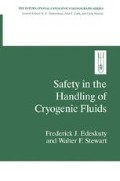Abstract
One of the most feared hazards in any system is that of unwanted combustion. The possibility of fire and explosion is a legitimate cause for concern and for additional attention to system safety. Although carbon monoxide, as well as oxygen and condensed air (see Chapter 9), can present a combustion hazard, here we will be concerned with liquid hydrogen and, to a lesser extent, with liquefied natural gas (LNG).
Access this chapter
Tax calculation will be finalised at checkout
Purchases are for personal use only
Preview
Unable to display preview. Download preview PDF.
References
Hord, J. (1976). Is Hydrogen Safe?, National Bureau of Standards Technical Note 690, Institute of Basic Standards, National Bureau of Standards, Boulder, Colorado.
National Fire Protection Association (1962). National Electric Code, Article 501—Class I Locations, National Fire Protection Association, Quincy, Massachusetts.
Cassutt, L., Biron, D., and Vonnegut, B. (1962). Electrostatic hazards associated with the transfer and storage of liquid hydrogen, in Advances in Cryogenic Engineering (K. D. Timmerhaus, ed.), Vol. 7, pp. 327–335, Plenum Press, New York.
Arthur D. Little, Inc. (1961). Final Report, Electrostatic Hazards Associated with the Transfer and Storage of Liquid Hydrogen, Contract AF 18(600)-1687, Arthur D. Little, Inc., Cambridge, Massachusetts.
Willis, W. L. (1966). Electrical conductivity of some cryogenic fluids, Cryogenics 6 (October), 279.
Willis, W. L. personal communication.
Chelton, D. B. (1964). Safety in the use of liquid hydrogen, Chapter 10 in Technology and Uses of Liquid Hydrogen (R. B. Scott, W. H. Denton, and C. M. Nicholls, eds.), Chap. 10, Pergamon Press, Oxford.
Edeskuty, F. J. (1979). Safety, in Hydrogen: Its Technology and Implications (K. E. Cox and K. D. Williamson, Jr., eds.), Vol. IV, Chap. 5, CRC Press, Boca Raton, Florida.
Straitz, J. F. III (1987). Flare technology safety, Chem. Eng. Prog. 83(2), 53–62.
Zabetakis, M. G. (1967). Safety with Cryogenic Fluids, Plenum Press, New York.
Witcofski, R. D., and Chirivella, J. E. (1984). Experimental and analytical analysis of the mechanisms governing the dispersion of flammable clouds formed by liquid hydrogen spills, in Proceedings of the World Hydrogen Energy Conference IV (T. N. Veziroglu, W. D. Van Vorst, and J. H. Kelley, eds.), Pergamon Press, Elmsford, New York.
Stewart, W. F., Dewart, J. M., and Edeskuty, F. J. (1990). Safe venting of hydrogen, in Hydrogen Energy Progress VIII (T. N. Veziroglu, ed.), Pergamon Press, New York.
Custer, R. L. P., and Bright, R. G. (1974). Fire Detection: State-Of-The-Art, NASA Lewis Research Center Report NASA CR-134642, Cleveland, Ohio.
Bowen, T. L. (1975). Investigation of Hazards Associated with Using Hydrogen as a Military Fuel, Naval Ship Research and Development Center Report 4541, Bethesda, Maryland.
Ordin, P. M. (1974). Review of hydrogen accidents and incidents in NASA operations, in Proceedings of the Ninth Intersociety Energy Conversion Engineering Conference, pp. 442-453, American Society of Mechanical Engineers, San Francisco, California.
Hardee, H. C, and Lee, D. O. (1977/78). A simple conduction model for skin burns resulting from chemical fireballs, Fire Res. 1, 199.
Weintraub, A. A. (1965). Control of Liquid Hydrogen Hazards at Experimental Facilities, Health and Safety Laboratory Report HASL-160, U.S. Atomic Energy Commission, New York.
Reider, R., Otway, H., and Knight, H. T. (1965). An unconfined, large-volume hydrogen/air explosion, Pyrodynamics 2, 249–261.
Brewer, G. D. (1991). Hydrogen Aircraft Technology, CRC Press, Boca Raton, Florida.
National Fire Protection Association (1994). Liquefied Hydrogen Systems at Consumer Sites, National Fire Protection Association Report NFPA 50B, Quincy, Massachusetts.
Edeskuty, F. J., Reider, R., and Williamson, K. D., Jr. (1971). Safety, in Cryogenic Fundamentals, (G. G. Haseiden, ed.), Chap. 11, Academic Press, London.
Author information
Authors and Affiliations
Rights and permissions
Copyright information
© 1996 Springer Science+Business Media New York
About this chapter
Cite this chapter
Edeskuty, F.J., Stewart, W.F. (1996). Combustion Hazards. In: Safety in the Handling of Cryogenic Fluids. The International Cryogenics Monograph Series. Springer, Boston, MA. https://doi.org/10.1007/978-1-4899-0307-5_7
Download citation
DOI: https://doi.org/10.1007/978-1-4899-0307-5_7
Publisher Name: Springer, Boston, MA
Print ISBN: 978-1-4899-0309-9
Online ISBN: 978-1-4899-0307-5
eBook Packages: Springer Book Archive

